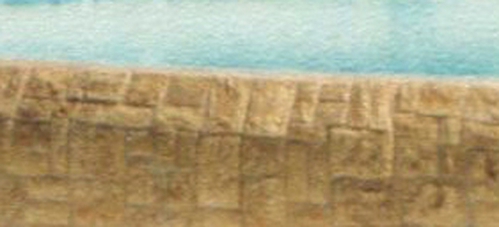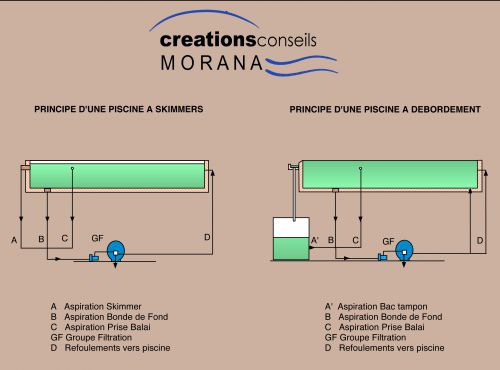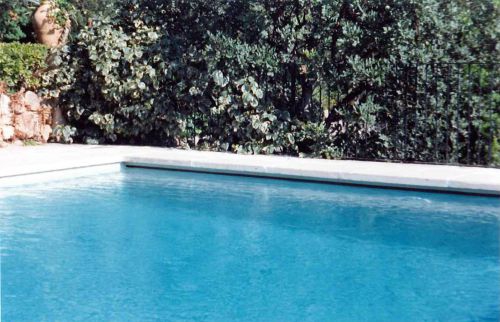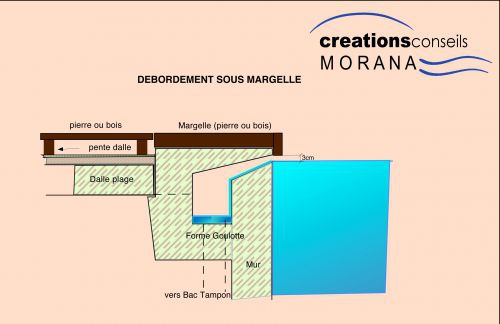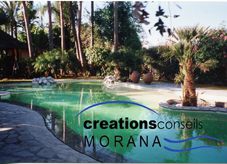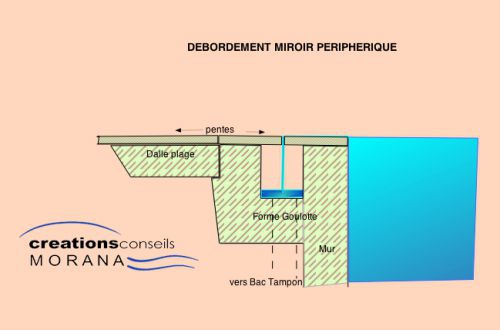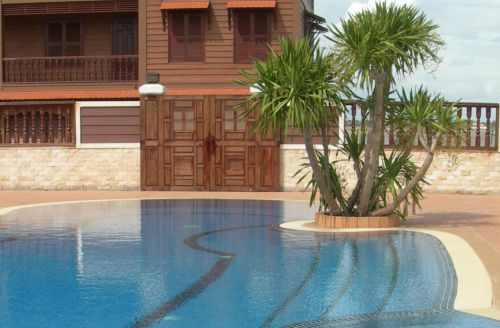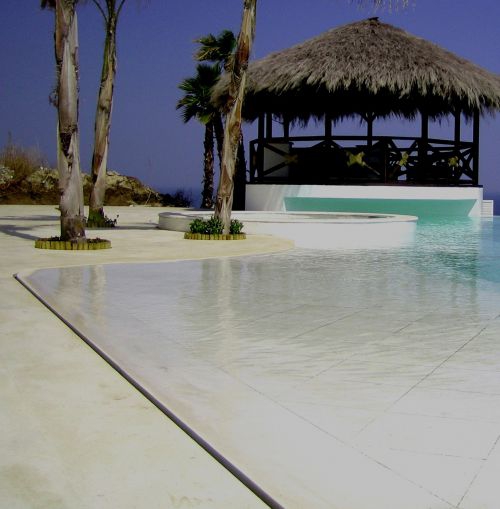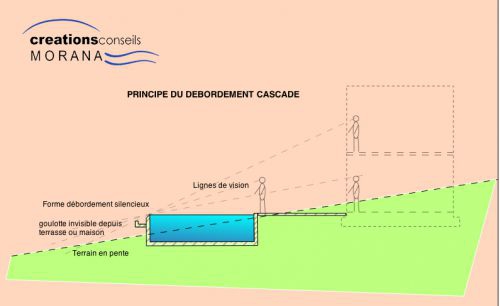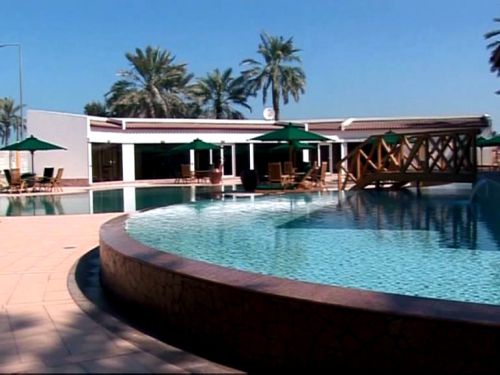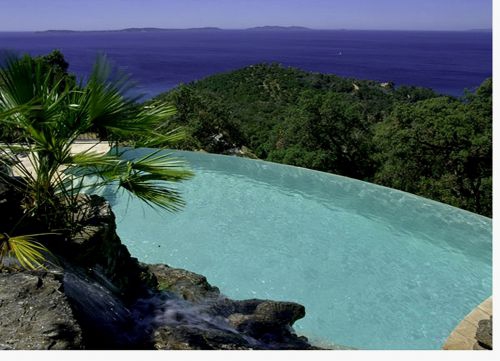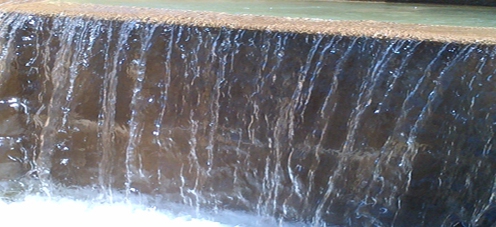Overflow Swimming Pools
Understanding the Overflow Concept
For a lot of people, overflow swimming pools seem to be very mysterious and unnecessarily expensive. Indeed, throughout my career I have seen people being opposed to the construction of overflow swimming pools for a number of reasons, some of the most notable ones reprimanding their excessive water consumption or prohibitive costs.
I think it is time to take a step back in order to separate truisms from popular fallacies. With the help of the diagrams below, we’re going to look at the overflow concept without getting bogged down by overly technical details.
Water Consumption
In simple terms, there is absolutely no difference between a skimmer pool and an overflow pool in regards to the loss of water.
In a skimmer pool, the water from the pool is sucked into the filtration system by the skimmer so that it may be filtered and then returned to the pool: In other words, it is closed circuit. Here, the only loss of water happens naturally through evaporation, which is most common during the summer.
With an overflow pool, instead of having the water sucked in by the skimmer, it is collected in a “water tank”. The water is then filtered and redistributed to the pool through a mixture of different return inlets ( floor & multi-flow). Since the pool is already full, the incoming water automatically spills over into the water tank, creating the overflow effect. Although the circuit is “technically” not closed, it is always the same water that flows in and out of the filtration system.
So, no need to worry about issues of water consumption.
Cost?
One last point which might be of interest to you: Many wonder about the costs of such pools. As illustrated by the diagram, they require a few additional elements: 1) A gutter to re-direct the water to the 2) water tank, 3) a check valve, 4) a buffet tank control to avoid the loss of water and 5) a system of water adjustment by solenoid valves ( to protect the pump). That’s all!
Whilst it certainly may be an additional cost, it isn’t as significant as some might expect.
When preparing a swimming pool project, it is highly advisable to ask for an estimate of an overflow swimming pool: not only is it highly beneficial in terms of the quality of the water, but it is also an undeniable aesthetic bonus!
You would like to discuss about your project, contact us!
Visit our website
Under Coping Overflow
It's probably one of the oldest type of overflow out there, and it still exists in countries like Morocco or Tunisia: the Under Coping Overflow.
Originally, the system ensured the adequate skimming of the water by injecting fresh (water) into the pool, which forced the surface water ( which is dirtiest) through the overflow channel and into the sewers. The fact that none of it was ever re-used meant a huge daily consumption of water that would, of course, be unacceptable by our current standards.
Today, the use of water tanks ensures that this type of overflow can still be used. However, much like the older version, the use of an under coping overflow certifies both an optimal recycling of the water (much more effective than skimmer pools) and a much lower rate of evaporation compared to other types of overflows.
Only downside: its aesthetic appeal is limited, if not practically inexistent. This is why it is most often recommended in projects where the client has no particular desire for any other type of overflow, or in cases where an overflow channel already exists.
You would like to discuss about your project, contact us!
Find out more visiting our website
Deck Level Swimming Pool
Referred to in such a way because of the precise alignment of the water with the level of the deck, this perimeter overflow is generally used to create a calm, relaxing atmosphere. Also, it allows people to visualise the entire water surface, regardless of where they stand. To many people, this creates the illusion of having a mirror laid out on top of the garden.
It tends to be perfectly silent, if the overflow channel is well-made, and is built using one of two methods: Swimming pool builders either use a steel grating to allow the water to escape to the storage tank, through the overflow channel, or they replace the grating with a small gap in the floor of the pool. Both the grating and the gap are always located at the junction between the deck and the pool.
For example, in the swimming pool shown below, the latter method was used.
But, regardless of the method you choose to use, it is important that you do not forget about the two symmetrical slopes situated near the edge of the pool. They ensure that rain water, or wastage left behind after cleaning the deck, doesn't get mixed in with the water from the pool. Inversely, they also guarantee that most of the pool water doesn't leak out onto the deck.
Below, you may find the two types of deck level swimming pools available to you: one using the grating system (left) and one using the more elegant and discrete "floor gap" system (right).
It is best used in projects that already possess an existing patio or a flat, even area. More importantly, it has the added benefit of being compatible with any swimming pool shape, be it geometric or free form.
You would like to discuss about your project, contact us!
See our website
Infinity Edge Pool
Because of its unparalleled aesthetic impact, this is, without a doubt, one of the most well known type of overflow in the world.
It is most often used for steep terrains and, thus, usually, only occupies one side of the pool. By looking out from the patio or the inside of the house, you get the illusion that the water disappears off the edge of the horizon.
As shown by the diagram, the success of this type of overflow is dependant on the overflow channel being completely invisible (and silent) from all angles. You can only guarantee this by having the adequate profile. Anything less, and you will also inevitably have to deal with a cacophony of noises set on by the resulting waterfall. (If, however, some of you looking for this kind of realistic waterfall, don't worry! It's quite easy to do: Discussed in our forthcoming article )
To illustrate my point regarding the need for an adequate profile, I've added two photos below: One taken from the overflow looking towards the house, and vice versa. As you can see, the water remains relatively still and does not cascade out into the lower part of the swimming pool.
This is, by far, my favourite type of overflow. In fact, the majority of projects I've worked on have it in some capacity.
But, what do you think of it? Please leave your comments and questions below.
You would like to discuss about your project, contact us!
Visit our website
'What sound do I want my infinity pool to make?'
When designing your infinity pool, it is important for you to know that there is the possibility of choosing between a silent overflow and a more noisy one ( ie: resembling the sound of waterfall)
However, I should warn you. Many of our clients who initially opted for the waterfall infinity pool have, later on, come to regret their decisions. Why? The cascading noise soon became very distracting and lost its original charm. As a result, we had to modify the original profile of the overflow in order to obtain the more discrete sound of trickling water.
Here's how we create the two different sound effects:
1) Waterfall: By having the edge of the pool suspended in mid-air, the water stays away from the vertical wall and free-falls into the lower pools. This creates the waterfall effect.
2)Silent: However, in this case, the edge and vertical wall are perfectly joined together: The water has no other choice than to trickle down the vertical wall, which ensures the resulting noise remains minimal.
You would like to discuss about your project, contact us!
Visit our website
